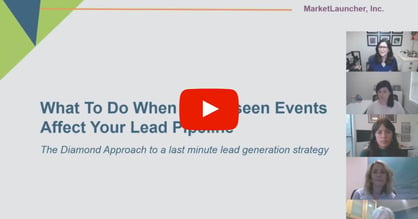Do you have a systematic process for developing and progressing leads? Can you track your activity at every stage of the lead development process and interpret the results? Do you have the right reporting tools in place to give you actionable insights? And do you have a means to identify and overcome challenges or roadblocks that may threaten the success of your sales strategy?
If you didn’t answer YES to each of those questions, you are in danger of not hitting your revenue goals.
At ML, we believe there are four cornerstones of every great sales development plan. We call it the "Diamond Approach". The Diamond Approach integrates into our Account Based Selling methodology to align cross functional efforts to produce new sales opportunities. It also provides an outlet for breaking down roadblocks and celebrating (and sharing) successes.
You know you’re on your way to a healthy sales pipeline when you can track your leads, gain insights to inform strategy, accurately forecast sales, and establish a predictable model for gaining new revenue.
Every great achievement begins with a well thought out strategy. At ML, we kick off every lead development program by creating a comprehensive playbook that contains the strategic elements needed to guide the team’s prospecting efforts. This includes plans for everything from outbound messaging and inbound lead development to protocols for passing leads from marketing to sales.
To build that playbook for your in-house team, you need the following:
The data your program will uncover is integral to ensuring the success of the entire project. Effectively integrated and managed, your data will tell you what is working and, if it’s not, signal that a switch in tactics may be required. If you are relying on spreadsheets and emails, then it’s time to step it up. You may already have a CRM in place to organize your contacts, but are you using it to its full potential? Is it providing you with the data you need to help your team sell better?
Many companies use a CRM but have a messy database and an unclear process that can’t be replicated by every sales rep. How do you clean things up?
Read our previous blog for a deeper how-to on HubSpot's sales enablement capabilities.
You may have your value proposition and general sales pitch on lock, but do you adapt your brand voice to specific buyers and their needs? Potential customers respond differently to a general marketing message than they might to one coming directly from an individual.
Make sure your sales team understands not just your company pitch, but the entire brand journey so they can customize the story for each sales approach. That includes email outreach. We prepare email sequences and a wide range of templates in HubSpot which our team can then personalize for every audience group and lifecycle stage.
Some of the types of emails you should have ready-to-go for your sales team include:
HubSpot’s email tracking software includes everything you need to measure the reaction your audience is having to different messages. Keep your eye on open rates and click-to-open rates to optimize as you go. Over time, you’ll be able to pick out certain phrases and content that resonate with your buyers, which can be valuable for both marketing and sales.
With strategy, reporting, and messaging in place, your team has the tools they need to roll out a predictable model for success. Now you are ready to execute your process.
If your CRM is already set up to give you full visibility of your pipeline, it will also give your sales reps clarity on how they should manage their time. We integrated Databox with HubSpot to provide our team with productivity trackers so they each know exactly where they are at any given time on the number of touches needed to get to a qualified appointment.
Establishing any new process takes some getting used to, so your team will need coaching to pick up these new practices with confidence. Sales coaching should never be a one-time training. Terri-Lynne Anderson is ML’s Director of Specialist Talent. She spends a lot of time working with each of our Specialists to remind them of these critical success factors:
Communication and collaboration are core components of the Diamond Approach. They provide the clarity that a strong sales program needs. At ML our senior leaders who are accountable for their corner of the Diamond meet regularly to discuss their respective responsibilities. These meetings are the place where challenges are discussed and overcome, and successes are celebrated and shared. It is through this alignment and communication that we can identify threats to each client program and identify ways to resolve those threats quickly.
The cadence of our Diamond Approach meetings is typically once per week, but there is no set rule as each organization has their own timetable. The common factor to success is that you do not push these meetings aside. It can be tempting, but you must make them a priority. Establishing a Diamond Approach complete with all cornerstones is the first priority for all of our client engagements.




